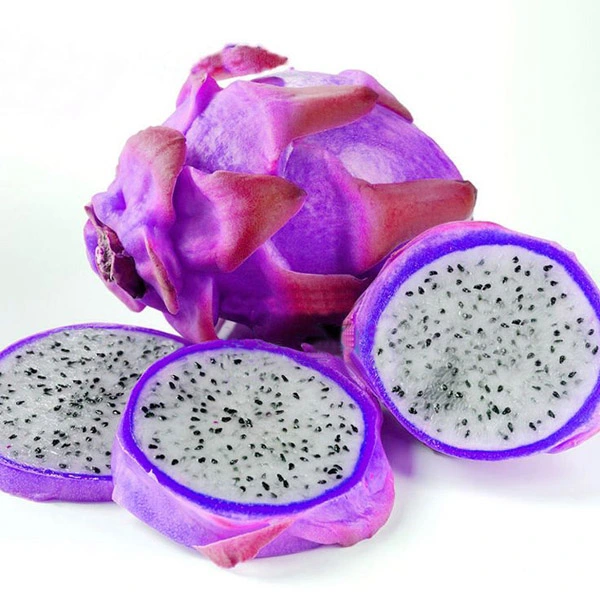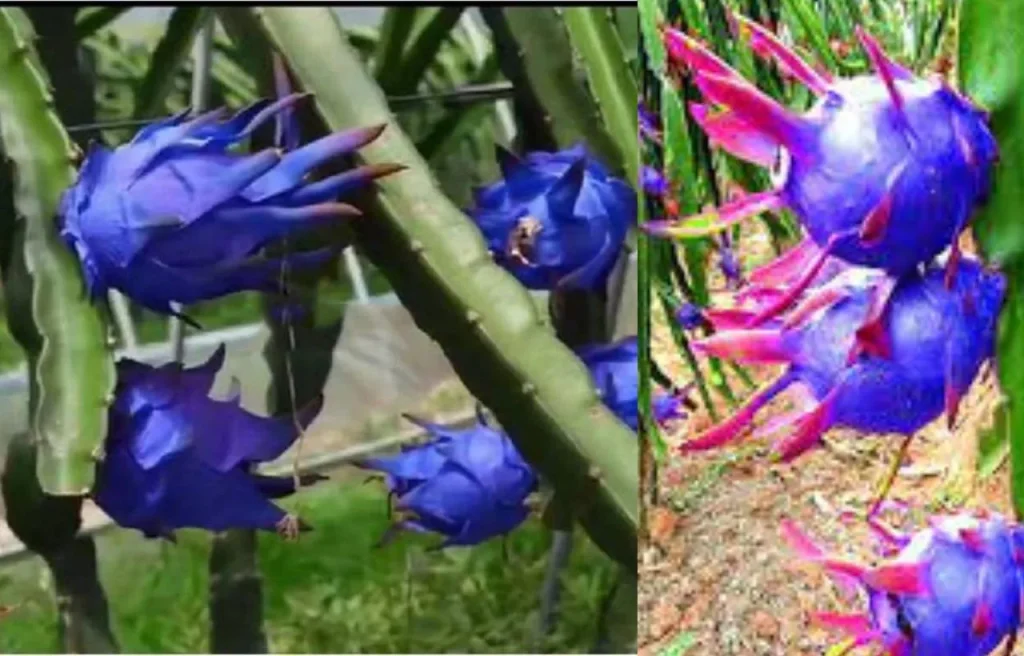blue dragon fruit is such of a kind. Don’t think that growing and nurturing the blue dragon fruit is like running in the Olympics. Gardening’s Core is always just a tap away to make your task easy in the garden. From this short read, you will be inspired to grow blue dragon fruits, what’s the goodness of the fruits, what’s the plant type, what elemental combination triggers the blue dragon fruit plant, etc. So, let’s enter into the best tips for growing blue dragon fruit plants in your garden yard.
Origin and Nutritive value of Blue Dragon fruit plant
So, where did this dragon fruit come from? Well, this nice and vibrant color fruit is native to South America and the fruit has very much expanded in Australia, Southeast Asia, the Caribbean, and Mexico. Initially, dragon fruit got this name in the year 1963 and since then the fruit is booming worldwide due to its flavors and outlook. Somehow, the dragon fruit flavor can match the Kiwi fruit.
This fruit is commonly known as the Pitahaya following its appearance and genus. Hylocereus undatusis the scientific name of the red, fleshy dragon fruit. Similarly, the blue dragon fruit plant has blue skin and ash-colored flesh with black seeds inside it. The blue dragon fruit plant is also known as the “Dragon eye”. Why the dragon fruit has a name?
Well, the outlook tells the story. The vibrant color and spiky skin are just similar to its name. By the way, it has somehow linked with the dragon mouth’s history. And the name came from that.
Okay, moving on to the most important point. What’s the nutritional value of this blue dragon fruit? According to the taste, the pitaya can be sweet and sour. It is a great source of vitamins- A, B, C, and E. However, it has plenty amount of water nearly 80%, essential minerals like calcium, phosphorus, and many more. This fruit is a good source of antioxidants, and can minimize the functions of harmful elements entered in your body. So, you can drink the juice of blue dragon fruit, or simply the cube-cut fruits, in cake, to get the essentials from this colorful superfood.
What does the Blue Dragon Fruit plant look like?
Okay, so how the blue dragon fruit will turn out in your garden/backyard? The blue dragon fruit plant is from the cacti family, perennials and often we consider it an ornamental plant.

Leaves: Big, green cacti-like leaves and white flowers are the signature features of the blue dragon fruit. It is a great climbing species. The big fat cacti leaves have spiked as well. A blue dragon fruit plant can height up to 20-30 feet or even more. In terms of habitat, the blue dragon fruit plant has branching habitat.
Flowers: The white flowers are the added value of this blue dragon fruit plant. Generally, the flowers have fragrance and in length, it is 36 CM and in width, these round-shaped flowers are 23 CM.
Stems: If we look lower, the blue dragon fruit plant has airy roots, and the stems are segmented. Each segment can have 3 to more long sections.
Fruits: What about the blue dragon fruit? It has blue skin, and white flesh, in general, the fruit is 10-15 cm long and can weigh up to 0.2-0.3 KG. The fruiting time can be from April to October season.
What do you need to grow the blue dragon fruit plant?
Of course, there are some sure shot techniques and elements that can help you to grow the best blue dragon fruit plant in the yard. Mostly the USDA growing zone 10-11, are best to grow the blue dragon fruit plant.
Why is it so? Zone 10 has California, Florida, and Southern America that can support many of the tropical plants due to their hot summer vibe in the geographic condition. Again zone 11 is also favorable for tropical shrubs, and succulents and it concludes Hawaii, Puerto Rico, etc. It doesn’t mean you can’t grow the blue dragon fruit plant anywhere else. You can grow them in the greenhouse if you are in extremely cold zones. So, let’s make a checklist of what do need for the blue dragon fruit plant…
Soil type: Sandy loamy-clay loamy soil can be the efficient medium to grow your blue dragon fruit plant. The soil with well-drainage and a high number of nutrients can facilitate the blue dragon fruit plant growth. In terms of the soil pH, it should be within 5.5-7.
Temperature: This exotic fruit plant love to grow in higher temperature. Generally, the temperature should be within 25℃ – 30℃.
Sunlight: Basically, the blue dragon fruit plant loves the full sun ranging from 6-8 hours of sunlight. But the blue dragon fruit plant be an indoor plant as well. As indoor plants, they can tolerate indirect sunlight.
Humidity and Rainfall: The blue dragon fruit plant like the humid environment. A humidity level 50-60% works well for the blue dragon fruit plants. In the tropical States, annual rainfall of 50-60 cm is best for the blue dragon fruit plant.
Fertilizer: In terms of this superfood plant, you need to put some extra, right? Well, a 16-16-16 and 13-13-13 ratio of NPK fertilizer can work well. Slow fertilizer, homemade compost and granular fertilizer are on the list for blue dragon fruit plant. After your plants get older, you can easily use the chicken manure/ other around the plants. In the summertime, March-September, you can apply the fertilizer.
Watering: Irrigation is very much needed for plant growth. But don’t go for overhead watering. You should allow your blue dragon fruit plants to stand in moist soil, not in a soggy soil medium. When the topsoil/ 2 inches of soil from the roots is dry, it indicates that your blue dragon fruit plant is craving for water.
What makes the blue dragon fruit plant happy?

The blue dragon fruit plant can be happy with pruning and cutting. It will initiate the fruiting process more quickly. With the help of pruning and cutting, you can give a definite shape to your blue dragon fruit plant. You can use any garden tool set to do this job. If you see any upset brunches, that are in the rotting process, immediately cut them off. One dragon fruit plant can even take 5-6 years to give away the fruits. So, don’t worry.
Can I re-pot my blue dragon fruit plants?
Blue dragon fruit plants aren’t just garden fruit, you can even grow them in containers/pots as houseplants. Keep in mind that the potting mix should have perlite, coco pit, and enough nutrients to support the dragon fruit seeds/seedlings. A pot 12 inches in depth and 15 inches wide, more or less, can work for your blue dragon fruit plant. Can you re-pot it? Why not? Within every two years, you can re-pot the dragon plants. The repotting keeps your plants healthy and growing upwards. This cacti plant spread well enough when it grows, so there should be sufficient soil in your container to support the blue dragon fruit plant.
Garden Bed and Plantation scenario
If you maintain the complete guideline, the blue dragon fruit plant will cheer in your garden. But in a garden bed, you must consider the spacing. The garden bed must be designed in 2 meters in both rows and length. If you see the market value, the fruit has a high demand. Vietnam is pretty much popular for exporting dragon fruits worldwide. So, planting for commercial purposes the plants may be arranged similarly with 2-meter spacing. And digging holes of 60 cm. However, in one acre of area, you can plant up to 1500-1700 plants in gross.
Diseases of Dragon fruit plants
Due to overhead watering, the plant may face powdery mildew. Or sometimes, the excess sunlight can turn the spiky waves yellow, and they curl. Flowering is hindered. The most common types of diseases are aphids, slugs, mites, mealybugs, and some bacteria. Cut off the weeds and try to always find an ecologically sound technique to remove the disease pathogens. Mix the fungicides/ pesticides, before planting the seeds/seedlings rather than after planting. If you maintain a well-growing condition for the blue dragon fruit plants, then the disease will be lesser.
FAQ
Have a look at the most asked questions about blue dragon fruit plants…
Is the dragon fruit plant real?
Yes, in the midst of dragon fruit varieties, blue dragon fruit/ dragon eyes are an existing one. You can see them in many countries. The outer peel is blue in color instead of red/yellow color. Again, some may find a different variety, which has blue and big seeded flesh with red peel. But both varieties are real.
What is the lifespan of a dragon fruit plant?
This perennial species can live up to 20 years for commercial purposes. If the plants get proper food, light and water they will live for many years and grows very fast. You can expect the fruits in the summer and the plants can give fruits 3 times and each time it can hold up 50 blue dragon fruits per plant.
How often should I water the dragon fruit plants?
You should not overwater the dragon fruit plants. Again, not drying out the plants. The best recommendation would be to water the dragon fruit plants, every once/twice a week to keep the soil moist and well-functioning.
Summary
A blue dragon fruit plant is of course not different from the other varieties of the regular Hylocereus dragon fruits. These fruits are uncommon, and best for health. Any beginner gardener/ commercial gardener can easily plant this food crop in the garden and nurture it lifelong to get the best, sweet fruits for the next recipe!
Happy Fruiting.

